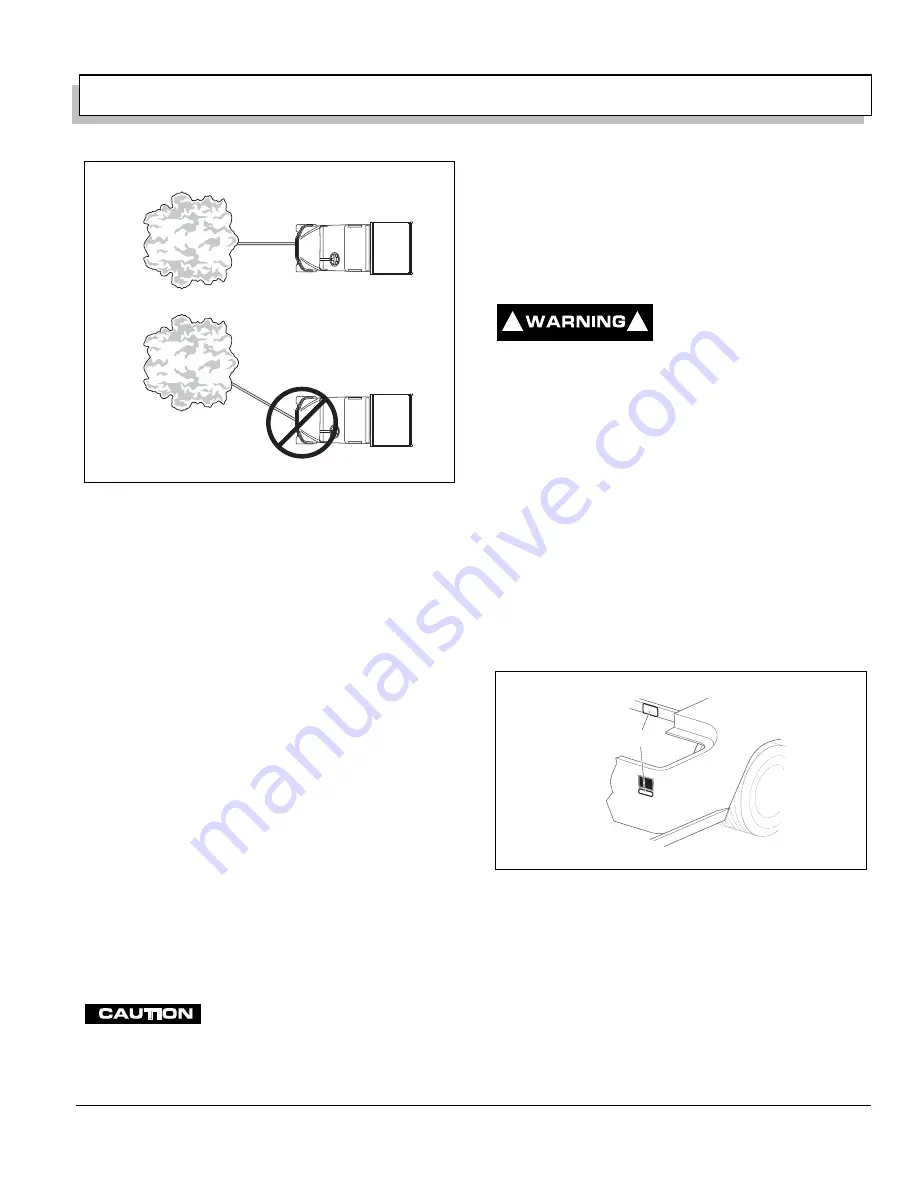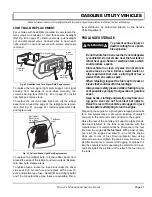
GASOLINE UTILITY VEHICLES
Page 7
Owner’s Manual and Service Guide
Read all of manual to become thoroughly familiar with this vehicle. Pay particular attention to all Notes, Cautions and Warnings
TOWING A TRAILER
The vehicle is equipped with a receiver that can be fitted
with a standard 1 7/8" ball. The trailer and its load must
not exceed 500 lbs (227 kg) and no more than 50 lbs (23
kg) tongue weight may be attached to the hitch. Remem-
ber that the overall capacity of the vehicle, operator, pas-
senger, contents of load bed and accessories must be
reduced to compensate for the trailer and load.
The range of motion of the trailer is limited by the ball and
hitch. The trailer should not be used on rough trails or
over objects such as logs, large rocks, holes, etc.
Never install baskets or extensions using the hitch
receivers (front or rear). Such items will change the per-
formance characteristics of vehicle and result in unsafe
handling, possible roll over or vehicle damage.
POWER CONSUMPTION
The vehicle uses a combination starter/generator to both
start the engine and charge the battery. The engine will
not idle; therefore, the battery cannot be charged while
the vehicle is stopped. Do not operate accessory items
(such as accessory lights, radios, winch, etc.) exces-
sively while the vehicle is stopped.
Overuse of accessories may drain the bat-
tery and leave insufficient reserve to start
the vehicle.
The generator is only capable of supplying 35 amps,
therefore, operation of all accessories could result in the
discharge of the battery even though the engine is run-
ning and the generator operating. Discharging the bat-
tery is known as deep cycling. The battery is not a deep
cycle model, but is a starting battery. Multiple deep
cycling of the battery will result in the premature failure of
the battery.
Vehicle battery must be fully charged before initial use.
Hydrogen gas is generated
as a natural part of the lead
acid battery charging pro-
cess. A 4% concentration of hydrogen gas is explo-
sive and could cause severe injury or death. Charging
must take place in an area that is adequately ventilat-
ed (minimum of 5 air exchanges per hour).
To reduce the chance of battery explosion that could
result in severe injury or death, never smoke around
or charge batteries in an area that has open flame or
electrical equipment that could cause an electrical
arc.
SERIAL NUMBER PLATE LOCATION
The serial and manufacturing numbers are located on a
plate on the passenger side of the dash housing (Ref Fig.
11 on page 7). Be prepared to provide these numbers
when ordering replacement parts or requesting informa-
tion on vehicle.
PREPARATION OF SEATS FOR SERVICE
Remove the protective plastic coverings from the seats
before placing the vehicle in service. The only function of
the plastic covering is to protect the seat bottom and
back rest during shipping. If the plastic covering is left on
the seat and becomes torn, dirt may get under the plastic
covering and be ground into the cover material. Water
getting under the plastic covering can become trapped
and eventually will damage the seat assembly.
Fig. 10 Do Not Pull at Angle
Correct
Incorrect
Ref Wps 2
Fig. 11 Serial Number Plate Location
!
!
Serial Number
Labels
Summary of Contents for Jacobsen 3500
Page 1: ...GASOLINE POWERED UTILITY VEHICLE ISSUED APRIL 2005 OWNER S MANUAL AND SERVICE GUIDE 28835 G01...
Page 6: ...Page iv NOTES Owner s Manual and Service Guide...
Page 10: ...Page vi Owner s Manual and Service Guide TABLE OF CONTENTS...
Page 14: ...Owner s Manual and Service Guide SAFETY INFORMATION Page x Notes...
Page 43: ...Page 25 GENERAL SPECIFICATIONS Owner s Manual and Service Guide GENERAL SPECIFICATIONS...
Page 47: ...Page 29 Owner s Manual and Service Guide VEHICLE WARRANTIES VEHICLE WARRANTIES...
Page 50: ...Page 32 Owner s Manual and Service Guide VEHICLE WARRANTIES...
Page 54: ...Page 36 Owner s Manual and Service Guide VEHICLE WARRANTIES CALIFORNIA 2004...















































